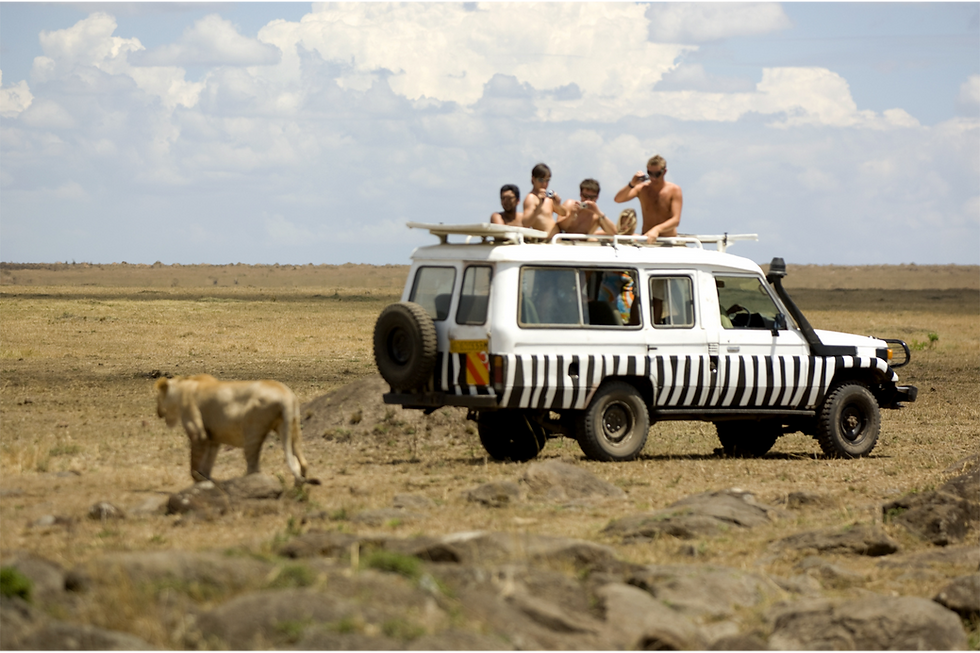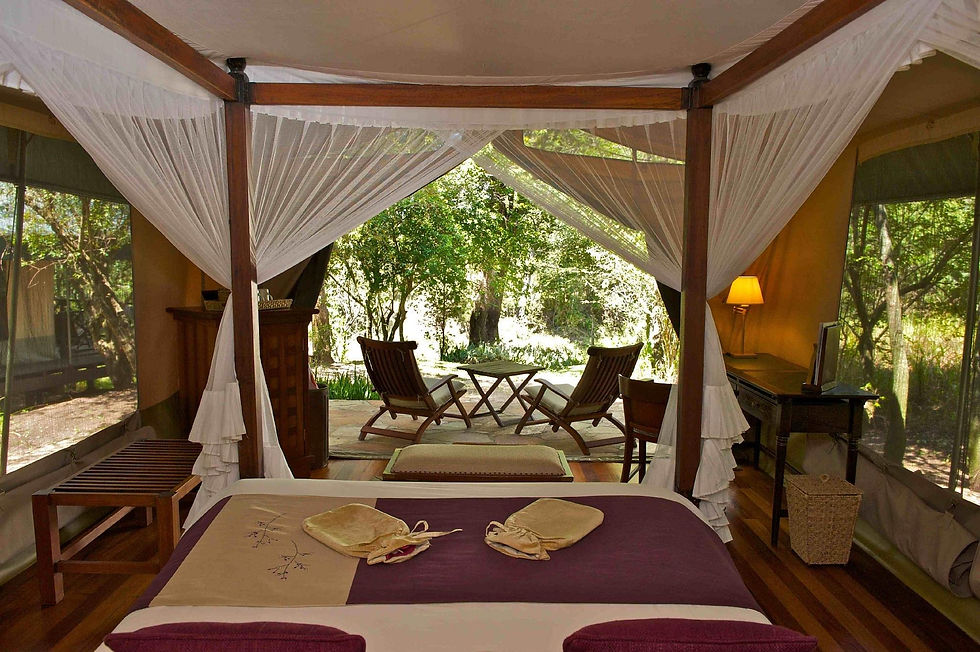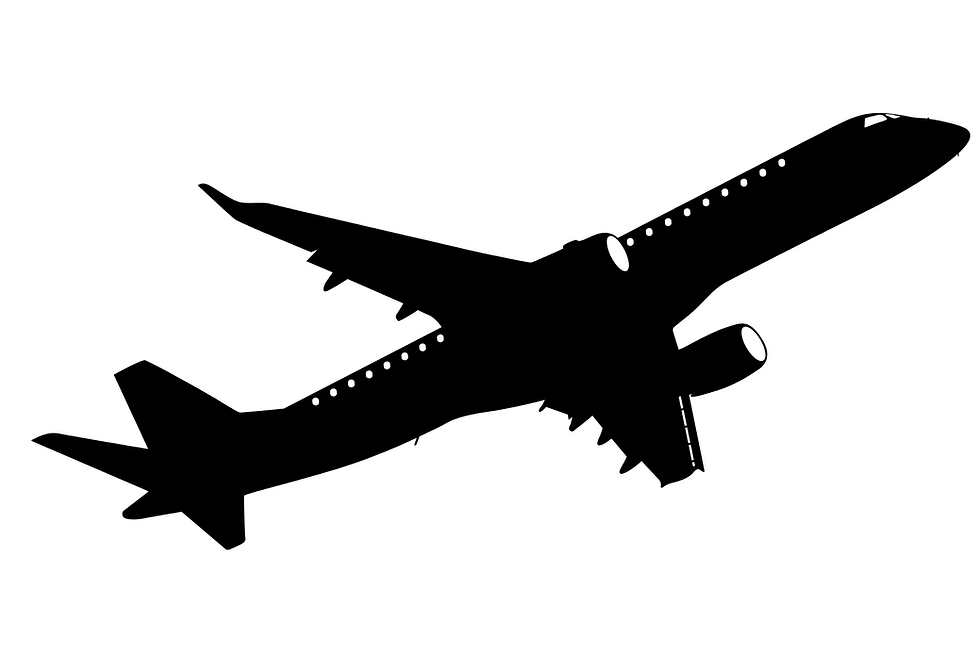Chasing the Big Five : 5-Day Masai Mara Safari
- Sonam Shah
- May 21
- 6 min read
Updated: May 29
Embarking on a safari to witness the Big Five - lion, leopard, rhinoceros, elephant, and African buffalo is a bucket-list adventure for wildlife enthusiasts. Kenya’s Masai Mara National Reserve stands out as one of the world’s premier safari destinations, offering unparalleled opportunities to see these iconic animals in their natural habitat. Its compact size, accessibility from Nairobi, and the spectacle of the Great Wildebeest Migration make it an ideal choice for first-time safari-goers. In this comprehensive guide, we’ll walk you through a 5-day itinerary, how to get there, the best time to visit, where to stay, and essential tips to ensure an unforgettable experience.

Why Choose Masai Mara?
The Masai Mara, located in southwest Kenya, is part of the Serengeti-Mara ecosystem, a vast expanse of savannah grasslands, acacia trees, and rocky outcrops that inspired Disney’s The Lion King. Compared to Tanzania’s Serengeti, the Masai Mara is smaller (1,510 km² vs. 14,750 km²), allowing you to cover more ground in less time. It’s also more accessible, with frequent domestic flights from Nairobi, and offers a higher chance of spotting rhinos, particularly in the Mara Triangle. The reserve is renowned for its high density of predators, especially lions and leopards, and the dramatic Mara River crossings during the Great Wildebeest Migration (July-October).
While the Serengeti offers similar wildlife and vast landscapes, its larger size and longer travel times from Arusha or Kilimanjaro International Airport make it slightly less convenient for shorter trips. For first-time visitors seeking a compact yet thrilling safari, the Masai Mara is hard to beat.
How to Reach Masai Mara

By Air
The most convenient way to reach the Masai Mara is by flying from Nairobi’s Jomo Kenyatta International Airport (NBO), East Africa’s largest hub, serviced by airlines like Kenya Airways, Emirates, and British Airways. From NBO, transfer to Wilson Airport (WIL), a 30-45 minute drive, for a domestic flight to one of Masai Mara’s airstrips, such as Keekorok, Musiara, Olkiombo, or Mara North. Airlines like AirKenya and Safarilink operate multiple daily flights, taking 45 minutes to 1 hour. Prices range from $290 to $550 per person, depending on the season. Most lodges include airstrip transfers in their packages, ensuring a seamless arrival.
By Road
For those who enjoy scenic drives, you can travel from Nairobi to the Masai Mara by road, covering approximately 225 km in 5-6 hours. The route is paved until Narok, after which the final 75 km is a bumpy gravel road, requiring a 4x4 vehicle. Popular entry gates include Sekenani (most common), Talek, and Sand River. While driving offers a chance to see the Kenyan countryside, it’s less popular due to the time and road conditions. Consider hiring a driver or joining a guided tour for safety and convenience.
Planning Your Arrival
International Flights: Book flights to Nairobi (NBO) with major carriers like KLM, Qatar Airways, or Lufthansa for competitive prices.
Domestic Flights: Reserve your Wilson Airport to Masai Mara flight at least 3-6 months in advance, especially during peak season (June-October). Check schedules on AirKenya or Safarilink.
Visas and Health: Ensure you have a Kenyan visa (apply online at eCitizen) and vaccinations like yellow fever, as advised by your travel clinic.
Best Time to Visit
The optimal time for a Masai Mara safari is the dry season (June to October), when sparse vegetation and concentrated water sources make wildlife easier to spot. This period coincides with the Great Wildebeest Migration, with dramatic Mara River crossings from July to October, attracting predators like lions and crocodiles. Temperatures range from 13°C/ 55°F in the mornings to 28°C/ 82°F midday, so pack layers.
The green season (November to May) offers lush landscapes, fewer crowds, and lower prices, but rain can make roads challenging. January to February is ideal for birdwatching and the wildebeest calving season, though rhinos may be harder to spot. For the best balance of wildlife and weather, aim for June to October.
5-Day Itinerary: Chasing the Big Five
This 5-day itinerary is designed to maximize your chances of seeing the Big Five while immersing you in the Masai Mara’s wildlife and culture.

Day 1: Arrival and First Game Drive
Morning: Arrive at Jomo Kenyatta International Airport (NBO) in Nairobi. Transfer to Wilson Airport for a 1-hour flight to a Masai Mara airstrip (e.g., Keekorok or Mara North).
Afternoon: Check into your lodge, such as the Angama Mara. Enjoy a welcome lunch, then embark on your first game drive. The Masai Mara’s open savannahs are home to lions, elephants, and buffalo, with leopards often spotted in riverine forests.
Evening: Return for dinner and overnight stay, soaking in the sounds of the African bush.

Day 2: Full Day of Game Drives
Early Morning: Set out for a pre-dawn game drive (around 6:00 AM) to catch predators like lions and leopards during their active hours. The Mara Triangle is a hotspot for rhinos.
Mid-Morning: Return for breakfast and relax at the lodge.
Afternoon: Opt for a cultural visit to a Maasai village to learn about their traditions, beadwork, and pastoral lifestyle. Alternatively, take another game drive to explore different areas.
Late Afternoon: Head out for an evening game drive, increasing your chances of spotting the elusive leopard or a lion pride.
Evening: Enjoy sundowner drinks in the bush, followed by dinner at the lodge.

Day 3: Hot Air Balloon Safari
Early Morning: Experience a sunrise hot air balloon ride, soaring over the savannah for breathtaking views of wildlife and landscapes. Book through operators like Governors’ Balloon Safaris (cost: ~$400-$600 per person).
Mid-Morning: Land for a champagne breakfast in the bush, surrounded by the Mara’s beauty.
Afternoon: Relax at the lodge, perhaps by the pool or with a spa treatment.
Late Afternoon: Take an evening game drive to spot nocturnal animals or continue your Big Five quest.
Evening: Dinner and overnight stay at the lodge.

Day 4: Cultural Exploration and Wildlife
Morning: Embark on an early game drive to maximize wildlife sightings, focusing on any Big Five animals you haven’t yet seen.
Mid-Morning: Return for breakfast.
Afternoon: Visit a Maasai village if not done earlier, supporting local communities through ethical tourism.
Evening: Enjoy the evening drinks and indulge in a sumptuous dinner.
Day 5: Departure
Morning: If time permits, enjoy a final game drive before checking out.
Mid-Morning: Fly back to Nairobi’s Wilson Airport.
Afternoon: Connect to your international flight from Jomo Kenyatta International Airport.
Places to Stay
The Masai Mara offers accommodations for every budget, from luxury lodges to budget camps. Book early, especially for peak season.
Luxury

Angama Mara
Cliffside suites with panoramic views are ideal for families.
Prices range from $1,000-$2,000 depending on the type of room and season.

Governors’ Camp
Historic camp near migration routes, excellent service.
Prices range from $800-$2,000.
Mid Range

Sarova Mara Game Camp
Spa, pool, near Sekenani Gate, great for comfort.
Prices range from $300-$600

Mara Intrepids
Rustic tents with modern amenities, expert guides.
Prices range from $250-$500
Budget

Keekorok Lodge
Basic amenities, central location, good value.
Prices range from $150-$300
Things to Keep in Mind
Health Precautions: Consult a travel clinic for vaccinations (e.g., yellow fever) and malaria prophylaxis, especially for wet season visits. Carry a basic first-aid kit.
Weather: Expect cool mornings (13°C/ 55°F) and hot afternoons (28°C/ 82°F). Pack layers, sunscreen, a hat, and insect repellent.
Wildlife Etiquette: Maintain a safe distance from animals, avoid flash photography, and follow your guide’s instructions to ensure safety and respect for wildlife.
Cultural Sensitivity: Dress modestly and ask permission before photographing Maasai villagers. Choose operators that support local communities.
Park Fees: Non-residents pay ~$80 per day, often included in safari packages.
Traveler Tips
Book Early: Lodges and activities like hot air balloon safaris fill up 6-12 months in advance during peak season.
Pack Smart: Bring binoculars, a camera with a telephoto lens, neutral-colored clothing, and sturdy shoes for walking safaris.
Tipping: Tip guides and lodge staff ($10-$20 per person per day, depending on service). Check with your lodge for guidelines.
Photography: Use a telephoto lens for close-up shots and avoid flash. Early morning and late afternoon light are ideal.
Conservation: Support eco-friendly lodges that contribute to conservation and local communities, like those partnered with Asilia Africa.
Comparing Masai Mara and Serengeti
While the Masai Mara is our focus, Tanzania’s Serengeti is equally renowned. Both parks share the same ecosystem, offering similar wildlife, including the Big Five. However, the Serengeti is larger, requiring more time to explore, and is accessed via Arusha or Kilimanjaro International Airport, with domestic flights or an 8-hour drive. The Serengeti’s northern region is best for migration crossings from May to June, while the southern plains shine during the calving season (January-February). The Masai Mara’s compact size and proximity to Nairobi make it more convenient for shorter trips, while the Serengeti offers more solitude in its vast landscapes.
Conclusion
A Masai Mara safari is a journey into the heart of Africa’s wilderness, where you can witness the Big Five, experience the Great Wildebeest Migration, and connect with the Maasai culture. With this guide, you’re equipped to plan a seamless adventure, from booking flights to packing the right gear. Start planning your dream safari today and prepare for an experience that will stay with you forever.






Comments